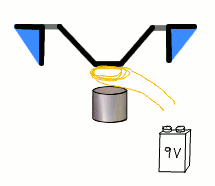Every audio speaker has a magnet in it. From subwoofers to iPod headphones, magnets provide the motive force that makes speakers move. Read on to understand the basics of speaker operation and how to make one with neodymium magnets. (This sounds like a good science experiment...)

Sound is a vibration in the air. Waves of changing pressure in the air move your eardrum, allowing you to hear sound. Just like ripples in a lake where you throw a stone, ripples in the air are what makes sound.
For a simple example, consider banging a drum. After hitting the drum, the surface vibrates back and forth, pushing the air in waves. When those sounds hit our ear, we hear noise.
If the vibration is slow, we hear a low pitch. If the vibration is fast, we hear a higher pitch.
So, to make a speaker all we have to do is drive a surface (often a cone shape) back and forth. The movement of the speaker makes waves of pressure in the air -- sound!

A pair of magnets can stick together. We're going to use this basic property of magnets to move our speaker. We use one permanent magnet and one electromagnet.
Permanent Magnet - An object that produces a persistent magnetic field. Neodymium magnets are a great example.
Electromagnet - An electric current running through a coil of insulated wire generates a magnetic field. While the current flows, it acts much like a permanent magnet. If no current is flowing, it stops acting like a magnet.
The permanent magnet is always on. The electromagnet we turn on and off by running current through it, or not.
For our speaker construction, we attach a coil of wire (the electromagnet) to the back of a movable surface. We used Magnet Wire, which is commonly used in everything from speakers to transformers. It has a very thin insulating coating, which lets you get many turns in a small area. UPDATE: We offer this wire in our Magnet Wire section!
We arbitrarily used about 12 feet of wire in these examples, wound into a coil of roughly 30-35 turns. We wrapped the wire around a piece of 1" diameter PVC pipe, end then slid the coil off the end of the pipe. The result is a coil just over 1" in diameter.
Next, we place a permanent magnet nearby. While no current flows through the coil, nothing happens. If we attach a battery to the coil, current flows, and the coil is attracted to the permanent neodymium magnet. Run the current in the opposite direction, and the coil is repelled away from the magnet.
Attaching and removing the electric current moves the speaker back and forth once. To make audible sound, we need to turn this driving current on and off many times per second. The video below runs a changing square wave through the coil. It starts at 30 Hz (cycles per second) and runs up to 600 Hz.
The electrical signal that comes from your music device sends many different frequencies and durations all over the same wire simultaneously. Whether using a record player or an iPod, the signal drives the movement of the speaker. In the video below, we plug our speaker into an old mp3 player.
You can make practically anything vibrate. Thanks to Nelson Bruns for the inspiration to make a speaker out of anything we could get our hands on. Thanks to Dan Gober for the music.
Obviously, the rough tape and paper speaker we constructed for a demonstration isn't going to win any sound quality awards. Speaker design is a mature art, with even the most inexpensive PC speakers producing a decent output. While you would optimize the electrical properties of these speakers (wire gauge, number of turns in the coil, magnet selection and placement, etc.), the mechanical design is also key. Some improvements in the mechanics could turn this demo into a decent sounding speaker.
Looking for inspiration? Inexpensive speakers are all around. Try taking apart on old speaker or set of headphones. There is much to be learned by examining the solutions used by others. Better yet, get your hands on some neodymium magnets and try making some of your own.
With a bit of glue on the coils, a much louder sound and quality was produced. It also helped to use both channels of the stereo output.